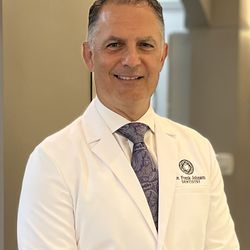A bridge is a dental restoration that can replace a single missing tooth. They are called bridges because they bridge the gap between two teeth. At Frank N. Johnson, D.D.S., P.A, there are several different types of bridges, and our dentist in Topeka, KS will recommend the right choice for you based on the location of the missing tooth and the condition of your teeth and mouth.
The Procedure for Dental Bridges
Dental bridges are used to “bridge” gaps created by one or more missing teeth. Typically, the “anchor” teeth are two healthy teeth on either side of the gap. Those teeth are prepared by removing enamel to allow a crown to be placed over them. Then, a prosthetic tooth, or pontic, is fused between the two crowns. Your dentist will carefully match the color of the pontic to your surrounding teeth.
The Different Types of Dental Bridges
Traditional Fixed Dental Bridges
A traditional fixed dental bridge consists of two dental crowns with a false tooth or teeth. This type of bridge is cemented to the natural teeth next to the space left by the missing tooth. Traditional fixed bridges are a prevalent type of bridge.
Cantilever Dental Bridges
Cantilever dental bridges are a good choice when patients only have two healthy teeth adjacent to the gap. Natural teeth or implants can support these bridges. Natural teeth support cantilever dental bridges. The teeth used as the anchors are reshaped and reshaped to appear like natural, healthy teeth.
Maryland Bonded Dental Bridges
Maryland bonded dental bridges refer to partial dentures held in place by metal clasps that fit around surrounding teeth. A Maryland-bonded dental bridge is sometimes referred to as a resin-bonded bridge because it uses resin to connect the bridge to surrounding teeth.
The Advantages of a Dental Bridge
- A dental bridge restores the appearance and function of the smile while preventing teeth from shifting into the gap left behind.
- Dental bridges are custom designed and fitted for an ideal fit.
- Dental bridges are also permanently bonded to the smile, unlike removable partial dentures, which can slip out of place.
- Dental bridges restore confidence and self-esteem, helping patients smile more and laugh openly.
Dental bridges can restore the appearance and function of your smile. To learn more about the benefits of dental bridges, get in touch with Frank N. Johnson, D.D.S., P.A. at 1244 SW Oakley Ave, Topeka, KS 66604, or call (785) 357-7706.
Location
1244 SW Oakley Ave,
Topeka, KS 66604
Office Hours
MON - THU7:30 am - 4:00 pm
FRI7:30 am - 11:00 am
SAT - SUNClosed
1244 SW Oakley Ave,
Topeka, KS, 66604
Phone: (785) 357-7706Text Us: (785) 357-7706

